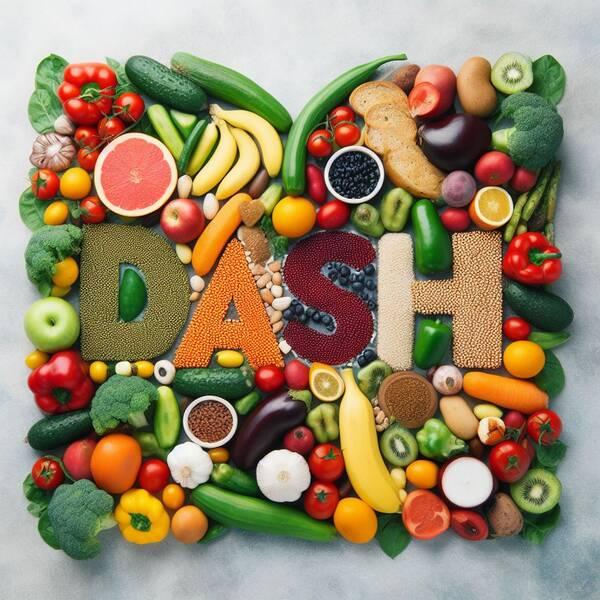
(Note: Some of the links in this post are affiliate links, and we will be compensated when you make a purchase by clicking through our links at no additional cost to you.)
In the fast-paced rhythm of modern life, our hearts often bear the brunt of stress and unhealthy eating habits. Hypertension, or high blood pressure, emerges as a silent but potent threat to our cardiovascular well-being. However, amidst the myriad of dietary approaches to combat this condition, the DASH (Dietary Approaches to Stop Hypertension) diet stands out as a scientifically-backed, heart-friendly guide. Let’s embark on a journey to unravel the scientific intricacies of DASH, exploring how this approach can become your compass to a healthier heart.
Understanding High Blood Pressure (Hypertension):
Before diving into the specifics of the DASH diet, let’s understand why high blood pressure is a cause for concern. High blood pressure or hypertension puts extra strain on your heart, making it work harder than normal. This can lead to serious health issues such as heart disease, stroke, and kidney problems. Lifestyle modifications, especially in diet, play a pivotal role in managing and preventing hypertension.
The Foundation of DASH Diet:
DASH isn’t a fleeting diet trend; it’s a lifestyle designed with your heart in mind. The foundation of DASH is rooted in research conducted by the National Heart, Lung, and Blood Institute (NHLBI). The DASH trials, initiated in the early 1990s, aimed to understand how dietary patterns influence blood pressure.
>>> Immerse yourself in the transformative power of the DASH diet with these must-read books
The Science Behind DASH:
Rich in Nutrients, Low in Sodium:
DASH promotes a nutrient-rich diet while limiting sodium intake. Key nutrients include potassium, calcium, and magnesium, which collectively contribute to maintaining healthy blood pressure levels. Potassium, in particular, helps the body balance sodium, reducing its impact on blood pressure.
Emphasis on Fruits and Vegetables:
The diet encourages a generous intake of fruits and vegetables. These plant-based foods are rich in antioxidants, fiber, and essential vitamins. Antioxidants help combat oxidative stress, while fiber aids in digestion and overall heart health.
Lean Proteins:
DASH recommends lean protein sources like poultry, fish, and legumes. These proteins provide essential amino acids without the saturated fats found in some red meats. This supports heart health by keeping cholesterol levels in check.
Whole Grains for Sustained Energy:
The inclusion of whole grains provides a steady release of energy and helps regulate blood sugar levels. This is crucial in maintaining stable blood pressure throughout the day.
Dairy for Calcium:
Low-fat dairy products are an integral part of the DASH diet. These provide a calcium boost, essential for maintaining strong bones and supporting cardiovascular health.

Moderation is Key:
DASH doesn’t banish indulgences; it emphasizes moderation. Occasional treats are allowed, but the focus remains on the overall nutrient profile of the diet.
Implementing DASH Diet in Real Life:
Understanding the science behind DASH is one thing; incorporating it into your daily life is another. Here are practical tips to make DASH a sustainable part of your routine:
Gradual Transitions:
Instead of overhauling your diet overnight, make gradual changes. Start by incorporating more fruits and vegetables into your meals and gradually reduce sodium intake.
Meal Planning:
Plan your meals in advance to ensure they align with DASH principles. This not only helps in maintaining a balanced diet but also saves time and reduces the temptation to opt for less healthy options.
Label Awareness:
Learn to read food labels to identify hidden sodium and make informed choices. Opt for fresh, whole foods whenever possible to minimize processed and packaged items.
Hydration Matters:
Adequate water intake is essential for a healthy cardiovascular system. It also aids in flushing out excess sodium from the body, supporting DASH’s sodium moderation principle.
Cooking Creatively:
Experiment with herbs and spices to add flavor to your meals without relying on excessive salt. DASH doesn’t mean sacrificing taste; it’s about finding healthier alternatives.
>>> Read more: Discover the power of nutritious and delicious eating with the Mayo Clinic Diet’s expertly crafted meal plan. Click here.
Monitoring and Adapting:
Regular monitoring is key to understanding the impact of the DASH diet on your blood pressure. Consider these steps:
Regular Blood Pressure Checks:
Keep track of your blood pressure regularly. Note any changes and discuss them with your healthcare provider.
>>> Read more: Discover the most accurate blood pressure monitor for home use. Click here.
Consultation with Professionals:
Consult a nutritionist or dietitian to tailor the DASH diet to your specific needs. They can provide personalized guidance based on your health status, preferences, and lifestyle.
Adjusting for Individual Needs:
The DASH diet is adaptable. If you have specific dietary requirements or health conditions, work with a professional to make necessary adjustments while still adhering to the core principles.
Lifestyle Beyond the Plate:
While the DASH diet is a powerful tool, a holistic approach to heart health involves more than just dietary changes. Incorporating regular physical activity, managing stress through techniques like meditation or yoga, and avoiding tobacco products all contribute to a healthier cardiovascular system.
The scientific foundation of the DASH diet makes it more than just another fad. It’s a sustainable lifestyle approach, rooted in research and designed to support your heart health. By understanding the principles and implementing them gradually, you’re not just managing hypertension; you’re nurturing a heart-healthy way of life. Remember, it’s not about perfection but progress. Your heart will thank you for every small step towards a DASH-inspired, healthier you.











